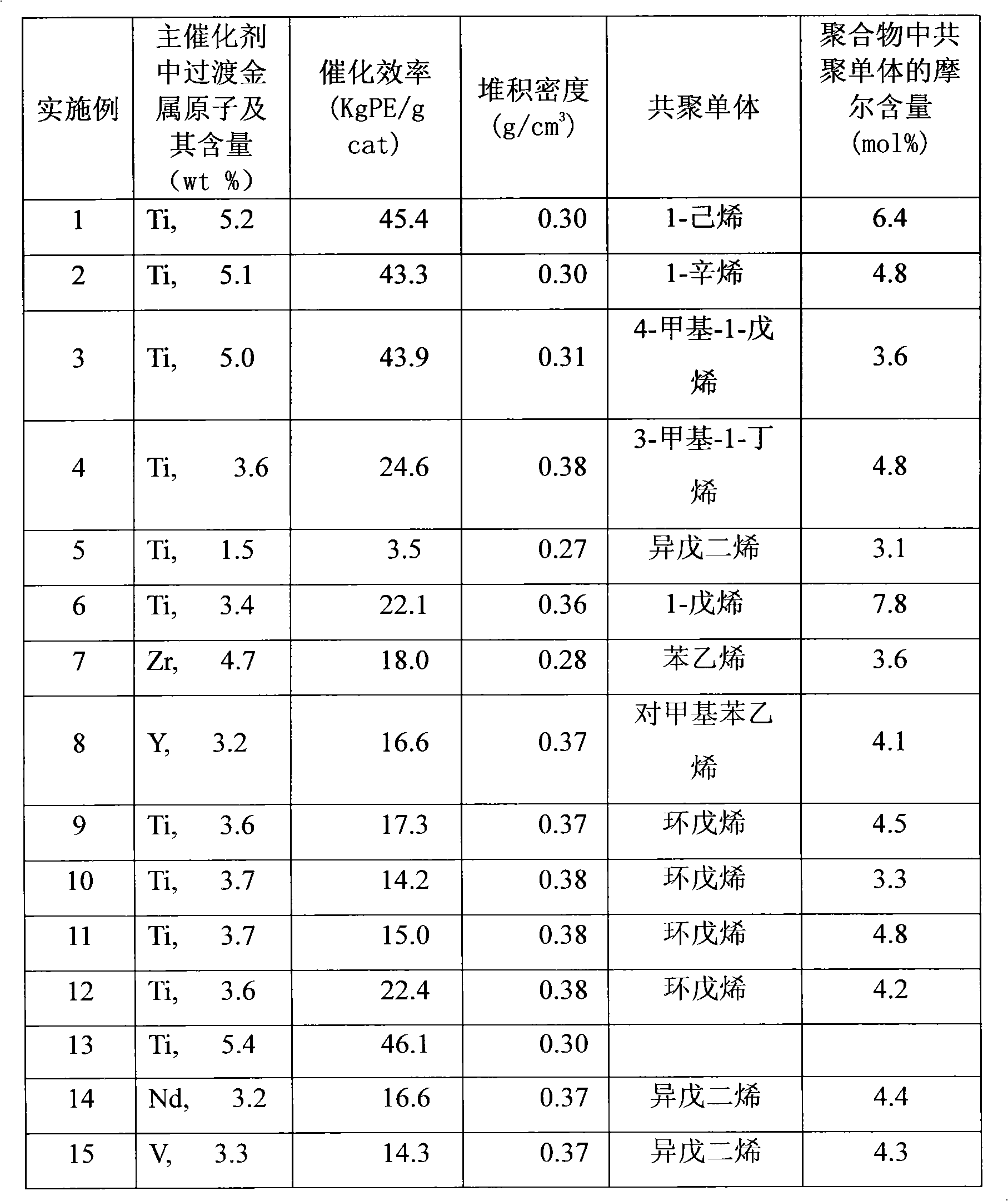Ethylene polymerization catalyst, preparation and application thereof
A technology of ethylene polymerization and catalyst, which is applied in the field of ethylene polymerization catalyst and its preparation and application, and can solve the problems of low copolymerization ability of comonomers
- Summary
- Abstract
- Description
- Claims
- Application Information
AI Technical Summary
Problems solved by technology
Method used
Image
Examples
Embodiment 1
[0037] 1) Prepare the main catalyst: In the reactor fully replaced by nitrogen, add 4g of magnesium dichloride, 3.5ml of epichlorohydrin, 5.5ml of tributyl phosphate, 75ml of toluene, 10ml of hexane, and 3.2ml of ethanol in sequence, and stir Raise the temperature to 70°C, after the solid is completely dissolved to form a homogeneous solution, keep the temperature for 1 hour; then cool down to -25°C, add 58ml of titanium tetrachloride dropwise, after the dropwise addition, add 4mL of trimethylsilyl mercaptan, 3.5ml of triethyl Oxyisopropoxysilane, after reacting for 1h, keep the temperature at -10°C for 1h, 0°C for 1h, 20°C for 1h, add 5ml of hexane, heat up to 60°C, add 10ml of hexane, react for 2h, stop Stir, leave the suspension, separate layers, extract the supernatant, wash twice with toluene, wash twice with hexane, and blow dry with nitrogen to obtain a main catalyst component with good fluidity and narrow particle size distribution;
[0038] 2) Copolymerization of ethy...
Embodiment 2
[0040] 1) Preparation of the main catalyst: In the reactor fully replaced by nitrogen, 4g of magnesium dichloride, 7.5ml of epichlorohydrin, 10.5ml of tributyl phosphate, 75ml of toluene, 8ml of hexane, and 6.2ml of isooctyl alcohol were added successively. Heat up to 60°C under stirring, after the solid is completely dissolved to form a uniform solution, keep the temperature for 1 hour; then cool down to -25°C, add 40ml of titanium tetrachloride dropwise, add 2.5g of triethylsilyl mercaptan after the dropwise addition, 2g Tetraethoxysilane, after reacting for 1 hour, heat up to 60°C, 3ml of hexane, react for 2 hours, stop stirring, let the suspension stand, separate layers, extract the supernatant, wash twice with toluene, and wash twice with hexane , blown dry with nitrogen to obtain a main catalyst component with good fluidity and narrow particle size distribution;
[0041] 2) Copolymerization of ethylene: After a 0.5-liter stainless steel autoclave was fully replaced with ...
Embodiment 3
[0043] 1) Prepare the main catalyst: in the reactor fully replaced by nitrogen, add 3g of magnesium dichloride, 5ml of epichlorohydrin, 10.5ml of tributyl phosphate, 75ml of toluene, 5.2ml of tert-butanol, and 3ml of hexane in sequence, and stir After the solid is completely dissolved to form a uniform solution, keep the temperature for 1 hour; then cool down to -25°C, add 50ml of titanium tetrachloride dropwise, add 3.5g of trinonylsilyl mercaptan, 3g of di Ethoxyisopropoxy tert-butylsilane, after reacting for 1h, keep the temperature at -10°C for 1h, 0°C for 1h, 20°C for 1h, heat up to 60°C for 2h, stop stirring, and let the suspension stand. Layering, extracting the supernatant, washing with toluene twice, washing with hexane twice, and blowing dry with nitrogen to obtain a main catalyst component with good fluidity and narrow particle size distribution;
[0044] 2) Copolymerization of ethylene: After a 0.5-liter stainless steel autoclave was fully replaced with nitrogen, 2...
PUM
 Login to View More
Login to View More Abstract
Description
Claims
Application Information
 Login to View More
Login to View More - R&D
- Intellectual Property
- Life Sciences
- Materials
- Tech Scout
- Unparalleled Data Quality
- Higher Quality Content
- 60% Fewer Hallucinations
Browse by: Latest US Patents, China's latest patents, Technical Efficacy Thesaurus, Application Domain, Technology Topic, Popular Technical Reports.
© 2025 PatSnap. All rights reserved.Legal|Privacy policy|Modern Slavery Act Transparency Statement|Sitemap|About US| Contact US: help@patsnap.com

